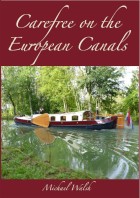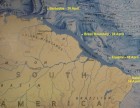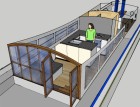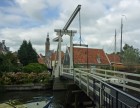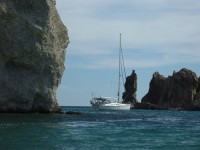Sequitur
Michael & Edi have headed out on a slow, thorough exploration of the globe.
| Vessel Name: | Sequitur and Zonder Zorg |
| Vessel Make/Model: | 2007 Hunter 49 and 1908 Wildschut Skûtsje |
| Hailing Port: | Vancouver, Canada |
| Crew: | Michael Walsh & Edi Gelin |
| About: | For our current location click, on Map & Tracking, then on the Google Earth logo. |
| Extra: | Follow us on Twitter: Follow @YachtSequitur |
| Social: |
13 January 2014
Another New Book Released
I am delighted to announce that my new book: Carefree on the European Canals is now in print and is available on Amazon.com, Amazon.ca [...]
26 April 2013
New Book Released
The proof copy of my new book arrived by courier today. I have approved it and it is now listed on Amazon for pre-order, with a publication date of 30 April. It is a rather large book at 680 pages in an 8.5 by 11 inch format with 315,000 words illustrated by over 2400 colour photos, charts and maps. [...]
24 April 2013
One Year Out of Brazil
One year ago today we sailed Sequitur out of Brazil after enduring more than six weeks in the least-friendly country that we had experienced during our three-year voyage. In the early evening of 24 April 2012 we crossed the line on the chart dividing Brazil from French Guyana and breathed a huge sigh [...]
27 October 2012 | Harlingen, Friesland
Planing a Metamorphosis
We have added a new post to the Zonder Zorg blog at: Planing a Metamorphosis.
29 September 2012 | Sneek, Netherlands
Onward to Friesland
We have arrived in Friesland and have added a new post to the skûtsje's blog at: Onward to Friesland
19 September 2012 | Hoorn, Netherlands
North From Aalsmeer
We have moved northward from Aalsmeer and I have added two new posts: Heading North From Aalsmeer and North From Amsterdam
13 September 2012 | Aalsmeer, Netherlands
Taking Possession
We are back in the Netherlands, and I have added some new posts to the ZonderZorg blog at: Taking Possession and Settling-In and Making Plans
20 August 2012 | Sequitur: St Augustine, USA - Michael & Edi: Vancouver, Canada - Nieuwe Zorg: Aalsmeer, Netherlands
Added a New Website
We have added a new website: Skûtsje ZonderZorg. Zonder zorg in Dutch means without worry. Our intention with the site is to provide a place to share some of the history, geography and culture of the skûtsje as we discover it. We will also use this place to document [...]
11 August 2012 | Sequitur: St Augustine, USA - Michael & Edi: Vancouver, Canada - Nieuwe Zorg: Aalsmeer, Netherlands
Still More Skûtsje History
We continued to attempt to track-down Douwe Albert Visser, who was the owner of Nieuwe Zorg in 1941 when she was re-registered. One of the problems we repeatedly encountered in our online searches was the effect of currently having Albert Visser and two Douwe Vissers as very competitive skûtsje racers, [...]
10 August 2012 | Sequitur: St Augustine, USA - Michael & Edi: Vancouver, Canada - Nieuwe Zorg: Aalsmeer, Netherlands
Some More Skûtsje History
While I was researching the history of Nieuwe Zorg, I finally found her first registration details obscured by an apparent typographical error in a transcribed online spreadsheet. She was listed as having been built in 1901 instead of 1908. I emailed the webmaster of the [...]
Preparing to Leave Puerto Montt
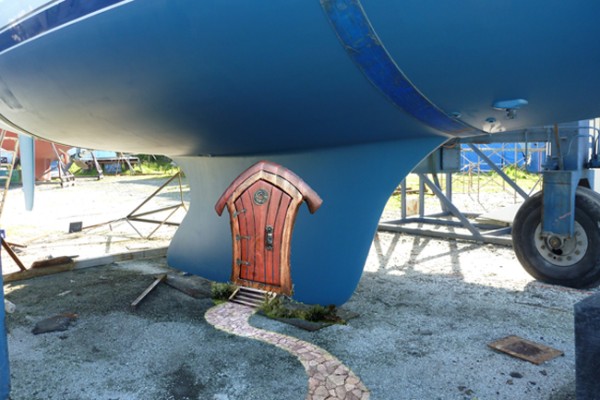

We have had poor service from the existing Jabsco macerator pumps from the beginning, with low pump volume, a slight seepage and its resultant odour. I had had Specialty Yachts Service change the one serving the forward head in late 2007 or early 2008 in Vancouver because of excessive seepage. Since then it had continued to seep whenever it was used, and I had gone through a lot of spray Lysol. The pump had not been used since before we had arrived in Puerto Montt in June, so the seeped effluent from the time of its last use had, thankfully, composted to a relatively benign mess.

The first thing I noted when I began to dismount the pump was the apparently standard-for-them shoddy electrical connections used by Specialty Yachts Service when they had replaced the pump. The crimp connectors were sloppily wrapped in tape with several gaps, allowing moisture onto the wires.

The next thing I noted was the hose clamps on the pump outlet. One of the clamps had missed the hose barb, and had been tightened down to restrict the outlet to about half of its diameter, greatly reducing its cross-sectional area. No wonder the pump strained so much during pump-out; its outlet was severely compromised.

I removed the Jabsco pumps and cleaned-out the bilge areas in preparation for the installation of the new Whale Gulper BP2552B pumps, which we had bought at River Marine in Vancouver in July. They had strongly recommended these diaphragm-type pumps, rather than a macerator-type. The thinking is that since the heads have their own macerator pumps, the contents of the holding tanks don't need the complication of further macerating at pump-out. A 38mm line from the tanks through the pumps and out the 38mm through-hulls will be very simple and efficient.

We need to replace the existing 25.4mm through-hulls with the new 38mm ones. In the forward bilge, instead of replacing the old through-hull that had been used by the macerator, we decided to put the watermaker inlet line onto it. This would solve two problems: move the watermaker inlet upstream of the blackwater outlet and provide an easily flowing bend in the hose from the pump to the new 38mm through-hull.

In the after bilge, the Jabsco installation had been properly done, with shrink seals on the wiring and hose clamps properly in place. This was in line with what I have seen with virtually everything that was originally done at the Hunter factory. It would have been wonderful if this professional level of work had been continued by their authorized dealer in Vancouver, both during our initial fit-out and with subsequent installations and servicing.
Regardless of how well it had been installed; however, the Jabsco pump was beginning to ooze. From what I have read and heard about these pumps, the bolts holding the body together are prone to corrosion, causing them to shear in one to five years, depending on use. I removed the old pump and began preparing the space for the new Whale pump.

To make better room for the new pump, I needed to move the shower sump pump, which was mounted beneath the shut-off valve for the former macerator pump. I found a better placement for it, hanging from the locker top across from the bulkhead where it had originally been installed. This positioning makes cleaning the pump filter much simpler. In the original placement we needed to remove the contents of the bilge bin down to the 40cm level to get to the filter. In the new location, the filter is just beneath the lip of the 60cm deep by one metre by one metre storage space and it can be cleaned with little or no disruption of the stored contents.

On Tuesday afternoon David and I removed the hose barb and elbow from the watermaker's through-hull and test-fit it to the former macerator through-hull to make sure the pieces mated before we committed to the plan. They were compatible, so we removed the former inlet through-hull for the watermaker and rebored the hole in Sequitur's bottom to 38mm. The hull is 20mm thick at that point, laid-up in layers of Kevlar and fibreglass.

We then moved to the main bilge and rebored the existing 25.4mm hole to 38mm. The hull here is 32mm thick and it continues to thicken as it approaches the root of the keel stub. It is always daunting to drill holes in the bottom of a boat, particularly large ones like these. At one metre below waterline, the 38mm hole in the main bilge will admit slightly over 5 litres per second. At 50cm depth, the one in the forward bilge will admit just shy of 3.6. That's a total of over 500 litres per minute; a lot of water.

With the holes bored, we now needed to properly close them. We cleaned and epoxy-sealed the cut surfaces and cleaned the surfaces immediately around them to receive the bedding compound.

The next day, after the epoxy had hardened, we used Sikaflex 291 Marine Sealant to bed the skin fittings, the backing disks and the threads of the ball valves. Once the compound had 'cooked', we once again had a watertight hull.

The second coat of bottom paint was applied and the masking tape removed to reveal the raised waterline with an attractive symmetrical accent line. We were nearly ready to go back in the water, so on Thursday afternoon I ordered a fuel truck to come on Friday morning to fill Sequitur's tanks with diesel. I also requested the travel-lift to lift us off our stands on Friday afternoon so we could apply a first layer of paint to the stand pad patches. The timing of the tides was perfect for this; we could hang in the slings until high water about 1500 on Saturday, allowing us to get two coats on the patches with proper drying times between.

On my way back from Alexandro, the marina manager's office, where I had been making the fuelling and travel-lift arrangements, I spotted a southern lapwing with two new chicks. The spring hatch has begun.

As I approached, the hen gave a signal to her chicks, and they slowly moved away.

Then one after the other the two chicks headed in beneath their mother's wings.

They quickly worked their way into a safe and warm place, and

I was left looking at a six-legged bird.

Our minds turned again to storing ship with cruising essentials. We have a very nice, inexpensive boat red, but we have yet to find a good cheap boat white. Our boat Merlot is about $3.65 a bottle, so we figured $4.00 should find us a satisfactory white. With Thursday evening's dinner we tasted three wines at 1900 to 2000 Pesos, and while they all went well with the sautéed merluza fillets and brown basmati rice, the clear winner was the 2011 Carmen Insignia Chardonnay. We'll have to lay-in a stock of it.

On Friday morning at 1000, precisely as arranged, the fuel truck arrived at Sequitur in the yard. We took on 825 litres of diesel for 561,000 Pesos, about $1140. Shortly after we had completed refuelling, we paused for a few moments of silence in commemoration of Remembrance Day. Then a little while later we watched as 11:11:11 of 11-11-11 happened. Eleven minutes and eleven seconds past eleven o'clock on the 11th of November 2011.

We took a bus into town and walked on a sight-seeing jaunt through the main shopping streets to Plaza de Armas. With a population of 175,000 in the 2001 census and a current estimate of 230,000, Puerto Montt is a rapidly growing trade centre for the southern regions of Chile. Across from the Plaza is Iglesia Catedral, the oldest building in Puerto Montt, dating to the city's founding in 1853. In the restoration after the 1960 earthquake, its facade was rebuilt in wood. Although the church looks Greek to us, many of the other older buildings in the city have a Germanic look; most of the early settlers were from Germany.

We continued through the downtown and up the hill to Supermarcado Jumbo, where we resumed our laying-in a four-month stock of groceries and supplies. Our shopping lists are constantly being amended; as soon as items are crossed-off, new ones find their way on. On this trip we lugged back two cooler bags and two huge canvas bags, each weighing in excess of ten kilos. There is no direct bus to or from Jumbo, so two bus fares are required; they do not know the concept of transfers here.

Then at 1600, again exactly as arranged, the travel-lift came and lifted Sequitur off her stands so we could paint the patches that had been under the pads. The stands had to be cut away, since they had been custom built and welded into place when we had been hauled-out. As soon as our bottom was clear of the pads, one of David's workers arrived to apply the first coat of anti-fouling paint to the missed patches and to the bottom of the keel. At 0800 on Saturday morning David applied a second coat to the patches and keel bottom, and a third coat to the leading edges of the bow and keel.

Shortly before the crew went off for their two hour lunch at 1300, they came and moved Sequitur to the lip of the launching dock to be ready for high tide at 1500. I spent the next couple of hours checking and re-checking the through-hulls from both inside and out. Then I hoisted our Canadian colours and the Chilean courtesy flag. I also organized lines and fenders on the starboard side so that we would be ready to secure alongside the float after being launched.

At 1500 the crew returned, and within a few minutes Sequitur's keel was wet again. As she was lowered past the lip, I hopped aboard and checked the bilges. Everything looked fine, so I switched on the engine and was delighted when it started immediately, and ran as if it had not been idle for over four and a half months.

We motored the short distance around the ends of the floats and into the marina and secured starboard side to on the long floating finger coming off the access ramp. The entire process went very smoothly; the yacht club's yard crew are experienced and efficient professionals. Once we were secured, I checked the bilges again just for peace of mind. Then I decided to start the generator to top-up the battery bank. It failed to start on the first attempt, so I tried it again and it caught and ran smoothly.

As I was preparing to hose-down the cockpit, David arrived saying he had a couple of hours we could use to complete the installation of the new black-water pumps. In the end, to make the six connections in the new 38mm blackwater lines and the connection of the re-routed watermaker inlet took us three hours. All of the hose barbs were installed with bedding compound, the hose ends were heated onto the barbs and double-clamped while still hot.

We tested the pumps, and were pleased with the results. We now have efficient and odourless blackwater plumbing. While many parts of the installation were straight-forward and I could easily do them on my own, I was pleased to have David with his professional experience, his proper tools and his appropriate bedding compounds. When we had finished the installation, he readily admitted that it was a two-man job.

We knew it was time to put Sequitur back in the water when we found her plans for putting down roots. Maybe she had grown comfortable in the yard and wanted to stay, or maybe she was taking pity on us for having spent so much time living up in a tree-house, that she decided to help-out with easier access. Whatever; Sequitur is now back in the water, our major projects have been completed, and we are left with a much shorter list of tasks to complete and things to buy before we continue south.

